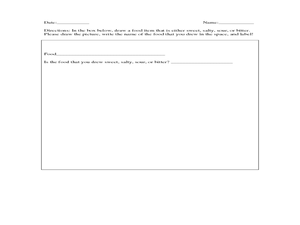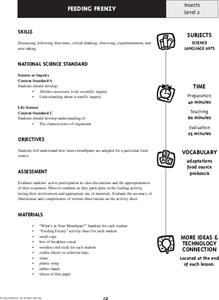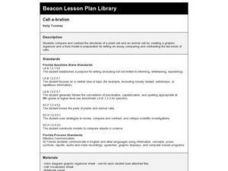Curated OER
Organic and Inorganic Waste
Students conduct a scientific investigation about organic or inorganic waste. In this organic or inorganic waste lesson, students create a compost heap to determine the difference between inorganic and organic waste. Students...
California Academy of Science
Global Climate Change and Sea Level Rise
Ice is nice, and its condition on the planet has a significant effect. Junior geoscientists experiment with ice melting in both water and on land to discover how each affect the rising sea level. This detailed instructional activity...
Curated OER
Lesson Plan for Cricket's Supper
Interested in a special folktale to read with your class? Then this lesson might be for you. Readers will build an understanding of the food chain while creating a storyboard that includes the characters, setting, and plot of the story....
Prince William Network
The Incredible Journey
Divide your school gym into breeding grounds and non-breeding grounds so that your zoologists can play a game simulating the seasonal migration of shorebirds. Players pick one of the included game cards and follow its directions, which...
PBS
Stories of Painkiller Addiction: The Brain on Autopilot
For some people, the force of addiction can be as biologically compelling as the drive for food or water. High schoolers watch a video segment about Ryan, a recovering addict, and learn more about how opioids and other drugs can affect...
Curated OER
Good Enough To Eat
Learners are introduced to the five food groups. In groups, they place different foods into the correct section of the Food Pyramid. Using different types of technology, they create one page of a class ABC book sharing what they know...
Curated OER
What's For Dinner?
Learners explore the food chain. They brainstorm and create a consumer-consumed food chains using magazine pictures and research materials. Students identify consumer-consumed relationships.
Curated OER
Introduction to Digestion: What Happens to a Hamburger?
Students explore the human body by analyzing how food is absorbed. In this food digestion lesson, students utilize health vocabulary terms by participating in a guessing game activity. Students discuss their own eating habits and conduct...
Curated OER
Feed Your Cells
Middle schoolers examine and research the human digestive system and what happens to the food we eat. They read the article, The Passage of Food, participate in an experiment with crackers, and write a paragraph summarizing the function...
Curated OER
The Life Cycle of the Butterfly
Second graders study the life cycle of a butterfly by observing metamorphosis taking place in a butterfly pavilion. Students illustrate their understandings of the body parts of a caterpillar and butterfly, as well as the life cycle,...
Curated OER
Those Cells Look Good Enough to Eat
Students explore the parts of the cell. In this cell lesson, students use foods to create cell models that represent the nucleus, cytoplasm, cell membrane, mitochondria, ribosomes, vacuoles, endoplasmic reticulum, and Golgi bodies...
Curated OER
Nutrition
Students explore nutrition. In this science lesson plan, students identify and describe the main nutrients in our diets that are needed by the body as a source of energy.
Curated OER
A Seed for All Needs
Students identify uses for plants. In this agricultural lesson, students read the book Spring Gardening and distinguish between food plants and flowers. Students plant flower in cups as a follow-up activity.
Curated OER
Terrific Taste Buds
Students explore descriptive writing by eating food in class. In this descriptive word lesson, students assess different foods in class such as jelly beans and utilize their vocabulary to describe the taste. Students read the story...
Curated OER
Showing Nature's Way-Plant Development and the Plant Parts We Eat
Students explore plant life. In this science lesson plan, students demonstrate and record the stages of plant growth and categorize food plants by identifying the edible part.
Curated OER
Feeding Frenzy
Students examine, through experimentation and simulation, how insect mouthparts are adapted for particular food sources, discuss how various animals have adapted to survive, play Feeding Frenzy game, and complete activity sheets.
Curated OER
Cell-a-bration
Fifth graders study the structures of a plant cell and animal cell. They create a graphic organizer and a food model. Finally, they write an essay comparing and contrasting plant and animal cells.
Curated OER
Let’s Make Cottage Cheese
Students watch the process of making cottage cheese from milk, then season and taste the product. In this making cottage cheese instructional activity, students make a connection between what they eat and where it came from. ...
Curated OER
Web of Life
Students collect information about various organisms in a forest ecosystem and create a mural that depicts organism interdependence. They then simulate a food web using a ball of string.
Curated OER
Growth and Changes in Plants
Students investigate the growth and changes in plants. They view a video and discuss the changes in plants. They work in small groups to demonstrate vocabulary words to the class. They visit a green house and take pictures of plants to...
Curated OER
Making Plastic
Learners experiment to create a plastic solution. In this science lesson, students use sodium borax and polyvinyl alcohol to create their solution, then identify, discuss, and chart observations on the end product.
Curated OER
Plate and Planet
Students investigate the health hazards of modern agriculture and how we can choose better food options. In this healthy eating lesson, students identify different indigenous people in photographs and discuss what they might eat....
Curated OER
Making an Edible Coral Polyp
Learners study anatomy. In this coral reef lesson, students recreate the anatomy of a coral polyp using edible materials. They work in pairs following step-by-step instructions given by the teacher. This lesson includes a list of...
Curated OER
The Radish Experiment
First graders grow radishes. In this Science instructional activity, 1st graders observe the growth of radishes in both the light and dark. Students discuss what plants need to live.























